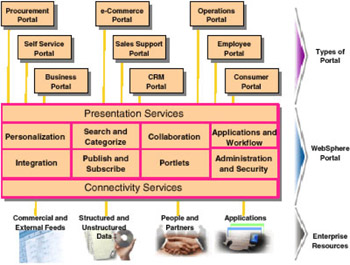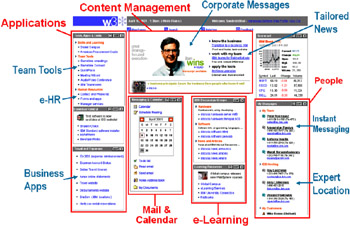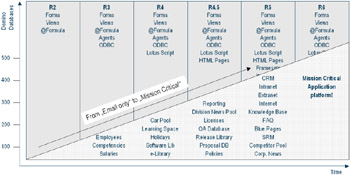1.2 Introduction to WebSphere Portal
|
| < Day Day Up > |
|
1.2 Introduction to WebSphere Portal
IBM WebSphere Portal allows you to establish customized portals for your employees, Business Partners, and customers. As illustrated in Figure 1-1, the framework architecture implemented in this product provides a unified access point to internal and external Web applications as well as portal access to other legacy applications. In this way, users sign on to the portal and receive personalized Web pages.

Figure 1-1: Horizontal and vertical portals
IBM WebSphere Portal was designed in response to the following fundamental business objectives:
-
A single point of access to all resources associated with the portal domain
-
Personalized interaction with the portal services
-
Federated access to hundreds of data types and repositories, aggregated and categorized
-
Collaboration technologies that bring people together
-
Integration with applications and workflow systems
IBM and many industry analysts have coalesced around the concept of horizontal and vertical portals. Horizontal portals are the primary infrastructure upon which a portal is built. Vertical portals are built upon the horizontal layer and represent a specific portal instance, usually defined by a major topic or domain.
As illustrated in Figure 1-2, the horizontal portal infrastructure consists of several modular subsystems including the following:
-
Presentation layer - a Web user interface plus pervasive device support
-
Personalization - the ability to serve dynamic response to the user based on personal profiles
-
Collaboration - tools that allow e-mail, team rooms, shared places, and so forth to be exchanged
-
Portlets - a framework for easily attaching software modules (portlets) and services
-
Applications and workflow - integration of legacy and new applications
-
Search and navigation - categorizing repositories of content and searching them for relevant information
-
Publish and subscribe - the ability to author new content and publish it to subscribers
-
Administration and security - basic Web site services such as page designers, performance monitors, cluster services, and metadata management Integration (metadata sharing, XML, connectors, standards, EAI).

Figure 1-2: WebSphere Portal architecture
WebSphere Portal provides additional services such as single sign-on, security, Web content publishing, search, personalization, collaboration services, enterprise application integration, support for mobile devices, and site analysis.
| Note | WebSphere Portal provides an extensible framework for interacting with enterprise applications, content, people, and processes. Self-service features allow end users to personalize and organize their own view of the portal, to manage their own profiles, and to publish and share documents with their colleagues. |
1.2.1 The workplaces idea
The workplace is a central concept of the WebSphere Portal. A workplace offers a portal user a view that is role-based, and delivers information based on the business function need within the organization. That means it gives us a single point of access to all the applications and information that we need to do our job. This implies that different users will get access to different applications. And within the application different functions and content. Bottom line, the workplace provides us with a tailored view that helps us to perform our specific business tasks and functions.
A workplace can include a large variety of applications. A few of those are very obvious - mail and calendar, for example - but you also see other business applications like HR, CRM, Learning and many more systems.
Figure 1-3 shows an example workplace.

Figure 1-3: Dynamic workplace Example
In today's world many of us work in more than just one function. For example: the team members that wrote this book all have additional projects in the works. Team members can easily switch between the team workplace for the Redbook and their other project places. In the redbook project our role is content authors; in other projects we have a variety of other roles, from programmer to project leader to supervisor.
The workplace approach enables us to easily switch roles by just navigating between different workplace. IBM calls this concept the Dynamic Work mode.
| Attention: | The "workplaces" word and concept used in this book should not be confused with the new Lotus Workplace, which is the new platform for collaboration built on J2EE and relational database technology. Lotus Workplace combines market-leading collaborative capabilities with the WebSphere Portal framework to enable simplified access to people, information, and business processes on a single platform. |
1.2.2 What the workplace means for Domino applications
It is important for us to understand why Domino integration into the Portal is so significant. Our experience with large Domino customers is that, over time, they utilized Domino for internal application development, and typically have developed dozens-even hundreds-of proprietary applications that contain critical data and business processes. If such a company now moves to WebSphere Portal, it is vital for the success of the Portal to be able to seamlessly integrate the Domino applications into the workplaces.
The history of Lotus Notes® and Domino
Let's look at the history of Domino to get a better understanding of the importance of Domino integration. In version 2, Notes was used primarily as an e-mail system. In subsequent versions Lotus enhanced programming elements, like the @Formula language, and views and forms that allowed users to build simple applications. Companies were impressed by the rapid application development concept that Notes introduced. Notes made it easy for developers or even power users to prototype applications. This new paradigm in application development was widely accepted by line of business (LOB) managers and users, and helped build the success of Notes/Domino. Since version 4.5, Notes could also be used for Web development; since then, it was ultimately accepted by many IT departments as a full-blown development platform.
Today many companies rely on their Domino infrastructure for business and mission-critical applications.
These range from document stores, to complex workflow applications supporting supply chains, to B2B business exchange Web sites.

Figure 1-4: Domino's history- From e-mail only to a mission-critical platform
1.2.3 Benefits of WebSphere Portal and Lotus Domino together
If we consider the current situation-Domino is recognized as a successful and reliable application infrastructure-we naturally need to raise the question why not use it as our Portal Infrastructure as well? Why should we move to the WebSphere Portal framework?
If you have worked with Domino to build larger applications, you might have experienced a few limitations of the current Domino platform.
One of the most common challenges in developing large-scale Domino Web applications is to make the Domino HTTP access scale and perform well under a heavy load. Not that it isn't possible, but it requires a lot of experience, and sometimes you have to spend a lot of time, for example, to implement caching strategies.
A workplace also has the need to implement personalization. On the one hand you need to deliver content that is relevant to the user's role, on the other you also want to allow the user to filter the information that is presented to them. Implementing this on Domino, for example executing queries on the fly, puts heavy load on the Domino server and calls for a big investment in the server hardware.
A portal most often serves as a single point of access into all systems of an organization and therefore it is important to be able to implement interfaces into other applications, besides Domino.
Taking these considerations into account, it makes sense to look at an alternative scenario for a portal implementation. Not one where Domino is completely out of the picture, but one that combines the strength and the scalability of a J2EE application server platform with the strong collaboration and document-centric capabilities of Domino.
Such a combination can have lots of advantages since it is:
-
Deeply integrated: WebSphere Portal provides the most robust integration with IBM's entire software portfolio, including your Lotus infrastructure; WebSphere Portal comes with out-of-the-box Portlets for IBM Lotus Notes and Domino, IBM Lotus Instant Messaging (Sametime®), IBM Lotus Discovery Server™, and much more.
-
Open: WebSphere Portal lets you integrate best-of-breed applications. IBM is helping define the key open standards for the portal industry.
-
Comprehensive: WebSphere Portal provides a complete framework that lets you answer all of your requirements for integrating your Lotus Domino assets with a single, powerful portal infrastructure.
-
Right for Contextual Collaboration: WebSphere Portal weaves the advanced collaborative capabilities of Lotus into your portal, enabling your organization to achieve the highest level of productivity.
-
Secure: WebSphere Portal provides granular security at the level you need for your applications and content. Use your Lotus Domino directory or other LDAP source.
-
Flexible: WebSphere Portal lets you adjust the presentation of data for a wide range of client devices.
-
Easily delegated: You can delegate sections of your portal to various "downstream" groups, enabling them to manage their segment of the portal.
-
Personalized: Users can personalize content within portlets based on profiles and business rules.
-
Global: WebSphere Portal supports multiple languages, enabling you to support your global organization.
|
| < Day Day Up > |
|
EAN: 2147483647
Pages: 103
- Integration Strategies and Tactics for Information Technology Governance
- An Emerging Strategy for E-Business IT Governance
- Assessing Business-IT Alignment Maturity
- Measuring and Managing E-Business Initiatives Through the Balanced Scorecard
- Technical Issues Related to IT Governance Tactics: Product Metrics, Measurements and Process Control